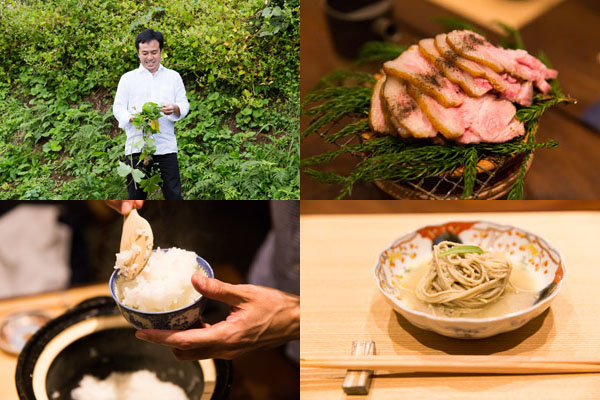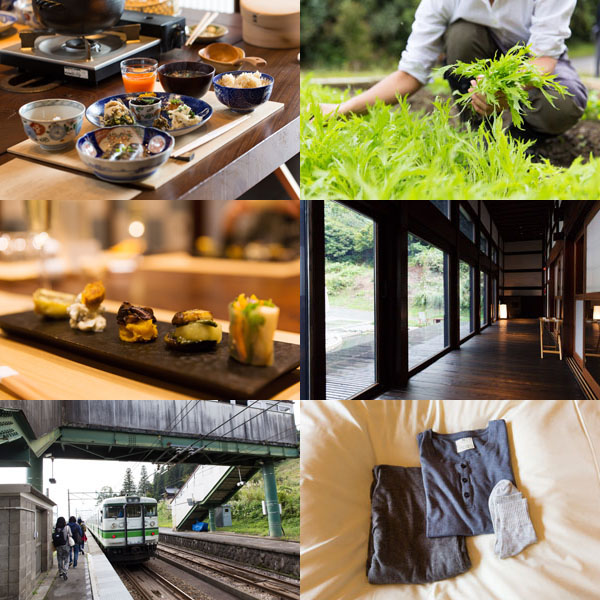Experience a Niigata Breakfast: Start Your Day with Authentic Flavors
Nov 06,2015
Experience a Niigata Breakfast: Start Your Day with Authentic Flavors
Nov 06,2015

Come face-to-face with the snow country’s traditional vegetables at Satoyama Jujo
Satoyama Jujo is a hot springs inn that opened its doors in May 2014. Located at an elevation of 450 meters in the mountains of Minami-uonuma, Niigata, the 6,500 m2 property includes the reception hall — a renovated former private home built 150 years ago, a hot springs bathing house, and an accommodation wing with 12 guest rooms (eight of which have attached open-air baths). All the buildings have been constructed to be in harmony with the surrounding environment.
Although just a little over two hours from Tokyo, Satoyama Jujo exists in a completely different world. The background music in this bucolic mountain village area, enclosed by mixed forests and fields, is the murmur of spring water, the calls of insects, and the playful rustling of leaves of trees and flowers. The vistas that reach your eyes, the sounds that reverberate in your ears, and the sensation of the air that caresses your skin — all are so remote and alien from the city, and yet the place feels somehow nostalgic. The question is, then, what kind of breakfast can you expect in a place like this?
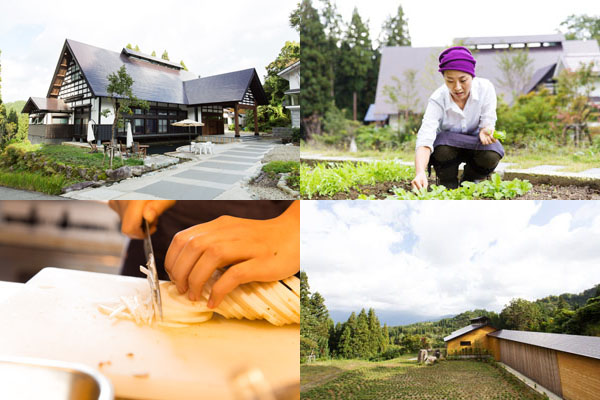
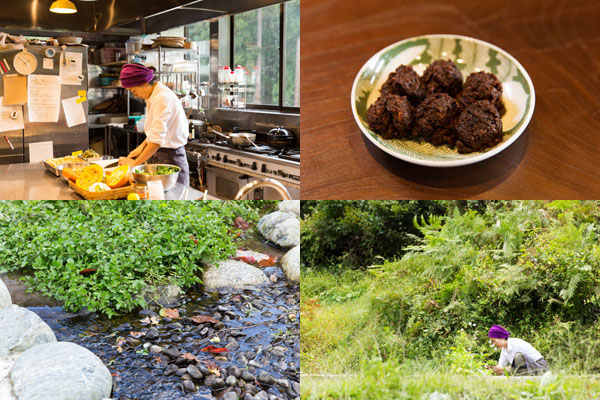
The inn’s restaurant is called Sanaburi. Sanaburi refers to the feast traditionally held after rice planting is finished to treat the people who helped plant the rice, while also praying for a bountiful harvest. The restaurant’s concept is to give a sense of the local area’s natural bounty and the power of the ingredients. Nearly everything on the menu is prepared with handpicked mountain vegetables and organic, pesticide-free vegetables sourced from nearby farmers or within the prefecture. The seasonings are all authentic, fermented naturally with no artificial additives, and all dips and sauces are homemade.
In charge of breakfasts at Sanaburi is Kuwakino Keiko, a food creator who studied traditional Ayurveda Indian medicine abroad and who researches worldwide vegetarian cuisine. We accompanied Kuwakino in the evening to a field near the inn to gather ingredients for tomorrow’s breakfast. We gathered leaf mustard, mizuna greens, and daikon radish leaves.
“I didn’t learn this until I came here, but Niigata still has so many traditional vegetables. Take eggplants, for example. They have over 20 varieties, each with their own shape and taste. I tried lots of ways to find the most delicious way to cook each of them, and the answer I eventually arrived at is to not handle them too much. Summer tomatoes and other vegetables are best eaten raw, so I serve them as is.”
Among the various cooking methods — stir-frying, steaming, simmering — the most useful is fermentation. The wisdom of fermentation is put to use to make preserves for the winter season as well as for everyday meals.
“We use koji [malted rice] purchased from a local koji shop. When fresh vegetables are lightly salted with koji, the umami of the ingredients is drawn out, making it taste that much better.”
Miso, probably the best known fermented food, is also made on site. Satoyama Jujo’s miso, which is prepared in an invaluable wooden tub and matured for more than three years, is one of their signature flavors.
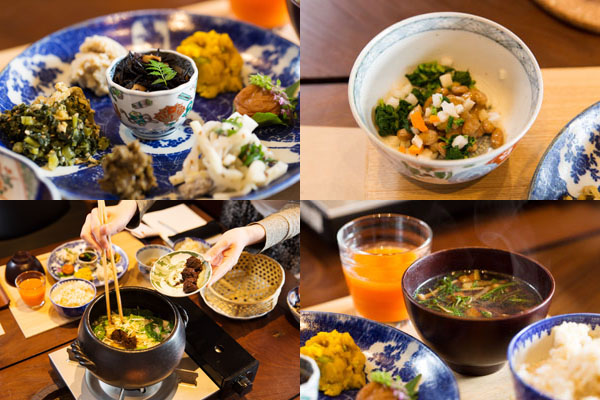
Here you can see Satoyama Jujo’s breakfast set menu in all its glory.
— Juice made from additive-free grated carrots
— Locally sourced kiri-zai [natto with chopped vegetables]
— Vegetable hot pot bursting with colorful vegetables
— Minami-uonuma koshihikari rice from Imai Satoshi
— Sea of Japan sardines simmered in ginger
— Assorted homemade side dishes
The 100-percent pure carrot juice has just a splash of lemon juice added. The juice’s pulpy texture makes it feel more like chewing than drinking. Despite having no sugar added, it tastes sweet, so sweet.
Kiri-zai is a local Uonuma delicacy that mixes together finely chopped daikon radish and carrots with large grained natto. It’s fun to feel each ingredient assert its own umami flavor in your mouth. No soy sauce needed with this dish.
The hot pot is made by dissolving homemade miso and then simmering mizuna greens, shungiku chrysanthemum greens, daikon radish, maitake mushrooms, enoki mushrooms, and deep-fried tofu in a kelp-based broth. Although cooked, the vegetables are still firm and crunchy at the core, with more than enough aroma and umami. The miso has a mellow taste with the salty edge rounded off. It is a soothing dish that makes you want to keep adding more vegetables and eat it forever.
The best koshihikari rice within the famous rice-producing Uonuma region is said to come from Minami-uonuma, and within Minami-uonuma, from the Nishiyama district, and within the Nishiyama district, from the Osawa, Kimizawa, and Kabanosawa areas. Satoyama Jujo serves mainly koshihikari rice from Kabanosawa with some from Osawa. On this morning, we were served freshly cooked brown rice that had been soaked overnight in spring water. It was so springy, soft, and sweet that if we were told it was white rice, we would have believed it. Each grain of rice has its own power, and we were determined to eat every morsel.
The only form of animal protein in the entire breakfast was the ginger-simmered sardines caught in the Sea of Japan. Slowly simmered in soy sauce and mirin seasoning, it is so delicious you can eat it all the way to the bones.
The star breakfast dish (top left photo) is the assortment of side dishes. On this day, there were seven items. Starting in the center with the fruity-tasting boiled and seasoned hijiki seaweed and going in clockwise direction from the very sweet squash salad, we have a pickled umeboshi plum that has been aged for three years and packs a punch; a slightly rich raw daikon radish, shungiku chrysanthemum green, and maitake mushroom salad with dressing; fuki-miso [miso-pickled butterbur sprouts] that had been prepared in the spring; light but flavorful daikon radish leaf and deep-fried tofu salad with dressing; and, finally, okara [tofu pulp] with lotus root, which has the pleasing crunchiness of lotus root. The number of items and the ingredients change depending on availability.
“I curate the menu with the hope that guests eat many varieties of vegetables, even if only a little of each. If guests appreciate the jimi — wholesome savoriness — of the ingredients, I feel I have done my job well.”
Jimi is a rarely used word that combines the notion of nutritional goodness and flavorful taste. But it’s a word that perfectly describes Sanaburi’s food, where you can savor the inherent power of natural local vegetables that have been mildly seasoned.

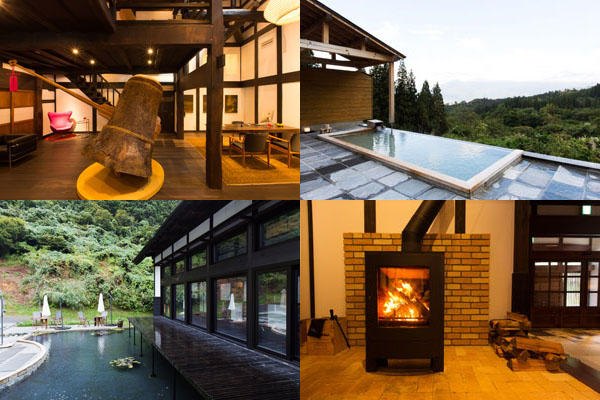
The attractions at Satoyama Jujo do not end with breakfast.
Let’s begin with the appearance of the place. Just looking at the inn’s main building — a renovated private home that has withstood the heavy winds and snowfalls of the region for 150 years — tells you it is rugged and dependable. Entering the reception area, you are confronted by a 10-meter-high atrium. Made entirely of zelkova, a strong hardwood, and treated with Japanese lacquer for additional protection, the exquisite structure strains your neck to take it all in.
Contemporary artworks, such as the commanding lucky mallet piece that sits in the reception area, are displayed throughout the building, and designer furniture from overseas decorates the lounge and guest rooms. This is a space where modern design aesthetics are blended in with the traditional beauty of old Japan.
Amanogawa — meaning the Milky Way, the inn’s open-air hot spring, affords a stunning view of Mount Makihata, listed as one of the 100 famous Japanese mountains, and features natural spring water said to make your skin beautiful. In spring and summer, you can enjoy the gradations of greenery; in autumn, the fall colors; in winter, a wall of snow; and at night, a sky full of stars. You’ll never find a situation like this in the city, where you can look out on nature in your most natural state.
A recommended activity is the Urayama Walking Tour, which takes place nearly every evening, weather permitting. Inn staffers will guide you on a walk around the mountain village environs. You can take in spectacular terraced rice paddies and pick and eat edible plants such as Japanese parsley, watercress, bulbil, and creeping woodsorrel that grow in the bushes beside the path. It’s an adventure.

Chief food creator Kitazaki Yutaka oversees dinners at the inn. He has an unusual background, having studied fine arts history at the International Christian University in Tokyo and then trained at a restaurant that received three stars in the Michelin Guide Kansai. The Satoyama Jujo set menu he prepared for us was equally impressive.
Every dish had a fresh twist, as if declaring “we want to compete on vegetarian fare”. There were five dishes arranged with five kinds of eggplants, which are a traditional vegetable, a nigiri sushi with lightly roasted eggplant as its main ingredient, and a soup with dumplings made of grated lotus root and natural mushrooms gathered in beech forests by a professional wild vegetable collector. Among all the excellent dishes, there were three in particular that surprised us.
The first was listed as Grilled ayu sweetfish. What arrived at our table, however, was soba noodles. Upon inquiring, we were told that to ensure the fish meat is soft, the ayu are quickly grilled while in an unconscious state and then their meat ground in a food processor to make a paste-like ayu sauce. This sauce is combined with hegi soba to complete the dish. One bite of the soba and the rich taste of ayu filled our mouths, convincing us that this is indeed grilled ayu sweetfish. We were speechless.
The second dish was cedar-smoked Echigo mochi pork. The dish and its name — Save the forests — were conceived by Kitazaki, who wanted to make effective use of the cedar trees that are devastating local forests. The cool, citrusy, penetrating aroma is a perfect match for the tender meat. The pickled cedar sprouts are also a rare treat that can only be eaten here. We were blown away by Kitazaki’s creative ingenuity.
The last dish was white koshihikari rice produced in Osawa. Smooth and dazzlingly shiny, with a sweet aroma and taste, it had the impact commensurate as the centerpiece of the meal. A local man who came to help with the gardening told us, “Even if you get the same koshihikari, the rice produced here in Osawa is the absolute best. If I go to a friend’s house elsewhere in the prefecture and I’m served their local koshihikari, I won’t have any rice. I’ll just eat the side dishes.” Life is hard once you know the taste of the very best.
The cheerful and accommodating staff at Satoyama Jujo are mostly young people in their 20s and 30s, many having moved here from urban areas. We were quite envious of them, getting to work in such an amazing environment surrounded by delicious food.
